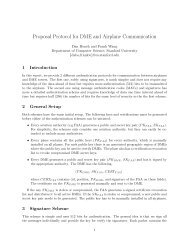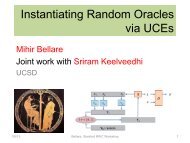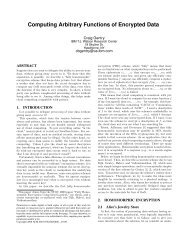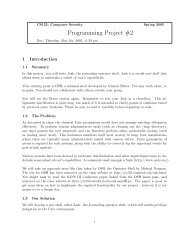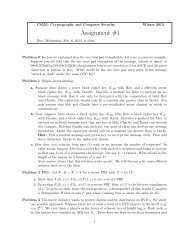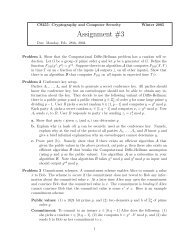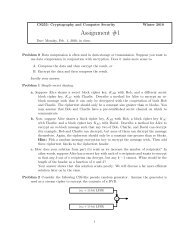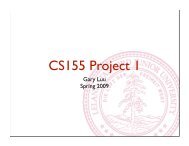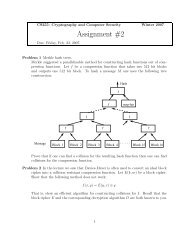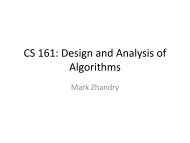Auditing SQL Queries - Stanford Crypto Group - Stanford University
Auditing SQL Queries - Stanford Crypto Group - Stanford University
Auditing SQL Queries - Stanford Crypto Group - Stanford University
Create successful ePaper yourself
Turn your PDF publications into a flip-book with our unique Google optimized e-Paper software.
the following queries:<br />
SELECT c.name FROM Customers c<br />
WHERE c.medication = ‘tylenol’<br />
SELECT c.name FROM Customers c<br />
WHERE c.medication = ‘advil’<br />
If Alice takes aspirin, she is not an indispensable tuple for<br />
either query and the query batch would be considered semantically<br />
unsuspicious whereas in reality by virtue of multiple<br />
negative disclosures, it revealed that Alice did in fact take<br />
aspirin and that she either has headaches or heart disease.<br />
However a weak syntactic auditor would label the query batch<br />
as suspicious. In fact, each query in the batch would be<br />
considered suspicious in its own right due to the indispensability<br />
of Alice’s tuple in some database instance; observe that<br />
both queries should in fact be considered suspicious since the<br />
answer to either query changes the attacker’s distribution on<br />
Alice’s medication and diseases.<br />
For further discussion on why the association breach detection<br />
guarantee does not hold for attackers with prior knowledge<br />
of correlations across individuals, and a discussion on other<br />
kinds of association views that can be framed, see our technical<br />
report at [10].<br />
That said, weak syntactic suspiciousness does not provide<br />
as strong disclosure detection guarantees as perfect<br />
privacy suspiciousness even in the absence of correlations<br />
across individuals. In the example from Section II, the query<br />
πname(P atients) would be suspicious under perfect privacy<br />
in case the secret view is πphone(P atients), whereas a weak<br />
syntactic auditor would deem it unsuspicious, thereby letting<br />
slip the revelation of the size of the forbidden view. But<br />
besides forbidden view sizes, is there any other information<br />
disclosure that such an auditor would not detect? It would<br />
be interesting to characterize exactly the kinds of disclosure<br />
detected under the different definitions and to explore other<br />
definitions in this space.<br />
VI. ONLINE AUDITING<br />
Other than detecting disclosures that have already occurred,<br />
a potentially important use of an auditor could be to prevent<br />
disclosures from taking place. An auditor could be used to<br />
determine whether a query should be denied in order to prevent<br />
a user from learning information about the forbidden view.<br />
Could the auditors we described above be used in an online<br />
setting?<br />
The notion of semantic suspiciousness and a semantic<br />
auditor don’t really make sense in an online setting because<br />
the act of denying a query itself could reveal information to<br />
a user that the auditor was seeking to protect. For example,<br />
consider the following forbidden view:<br />
AUDIT p.name, p.disease FROM Patients p<br />
WHERE p.zipcode = 94305<br />
Now suppose the following query is permitted by a semantic<br />
auditor and it returns only one disease.<br />
SELECT p.disease FROM Patients p<br />
WHERE p.zipcode = 94305<br />
But the following query is denied<br />
SELECT p.name From Patients p<br />
WHERE p.zipcode = 94305 and p.name = ‘Alex’<br />
The only reason that this could happen is that Alex who lives<br />
in 94305 is actually in the database and his disease was the<br />
one returned by first query. Even though the second query<br />
was denied, the name-disease association of an individual in<br />
the forbidden view was revealed. This is because the auditor’s<br />
reasoning process for the denial involved the answer to the<br />
second query which was information that was unavailable to<br />
the adversary prior to the denial.<br />
On the other hand, if all we wish to protect is the association<br />
privacy of individuals and their sensitive attributes, and are<br />
satisfied with the association breach detection guarantee of<br />
Theorem 8, a weak syntactic auditor could be used in conjunction<br />
with the association views of Section V in an online<br />
fashion. Suspicious queries would be denied, unsuspicious<br />
queries would be answered, and an attacker would not learn<br />
a posterior distribution over the sensitive attributes of any one<br />
individual that is different from his prior. In particular, let Q =<br />
{q1,...,qt} be a sequence of queries and A = {a1,...,at}<br />
be the answers supplied by the weak syntactic auditor. Here<br />
each ai is either the true query result of qi over the database<br />
or a denial. Then for each individual I ∈ I we can show<br />
that for any attacker with a prior distribution D satisfying the<br />
conditions enumerated in Section V,<br />
PrD{S(I) =s|q1,...,qt,a1,...,at} = PrD{S(I) =s}<br />
In this scenario, denials do not leak additional information<br />
because the decision to deny a query is not based on the<br />
actual database state. Suspicious queries are determined by<br />
considering all possible database instances and not by using<br />
any information that is unavailable to an adversary. The<br />
adversary can himself carry out the auditor’s reasoning process<br />
and predict when his queries will be denied.<br />
Also note that due to the decomposability result of Theorem<br />
3, suspiciousness of a query can be determined independently<br />
of all past queries and thus the auditor need not<br />
maintain an audit trail of all past queries posed. In the interests<br />
of avoiding a very draconian denial policy, it would be worth<br />
exploring relaxations of weak syntactic suspiciousness that<br />
permit a bounded change in an attacker’s posterior distribution<br />
on the sensitive attributes of an individual for an association<br />
breach detecting set of audit expressions. This is a very<br />
interesting avenue for future research.<br />
VII. AUDITING AND ACCESS CONTROL<br />
As we have seen, previous work in [8], [2] can be cast in<br />
the auditing framework proposed in this paper. The differences<br />
lie in the definitions of suspiciousness<br />
In database access control literature, the problem studied<br />
is essentially the dual of the auditing problem: Given a set<br />
of “authorization views”, V = {V1,...,Vk} for a user and



